Early Season Insects of Corn
-
Early season corn insects feed on seeds and seedlings, which may result in plant injury, stunting, delayed emergence, or stand loss
-
Scouting is necessary to determine the types of insects present and their population densities in order to make informed management decisions.
-
Sampling methods vary based on insect species and include scouting, soil sampling, and baited traps.
Be on the Lookout
Early season insects should be on a grower’s mind when examining seedling emergence and corn stands this spring. Early season insects that feed on corn seeds and seedlings can cause plant injury, stunting, delayed emergence, or stand loss.
Early Season Insects
larvae are yellowish-white, about 1/4 inch long, and lack a defined head and legs. Seedcorn maggot larvae burrow into the seed and feed on the kernel before germination (Figure 1).
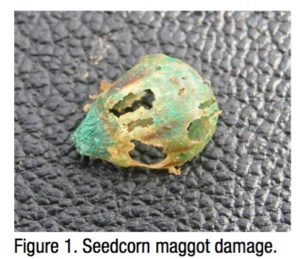
are the larval stage of May and June beetles. They can be distinguished from other grubs by the zipper-like spines under the abdomen (Figure 2). White grubs feed on plant roots, which can kill corn seedlings or stunt larger corn plants.
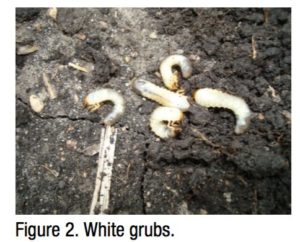
are slender, hard-bodied, and brownish in color. They are about 1 inch long when fully grown and feed on seeds and seedlings (Figure 3)
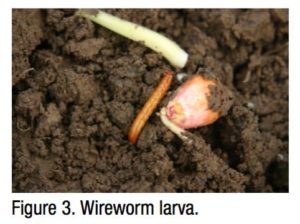
larvae vary from light-gray to black in color and are about 1 1/2 inches in length (Figure 4). Larvae feed on corn either at the base of the stem or underground, which can lead to cut or clipped seedlings.
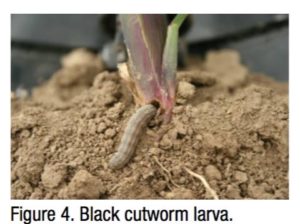
are small, 1/5 to 1/6 inch in length, with a black body and white forewings that create a white X on the abdomen (Figure 5). Newly hatched nymphs are bright red. Chinch bugs feed at seedling crowns and belowground on roots and stems. Feeding damage from both adults and nymphs causes reddish discoloration of leaves and stems.
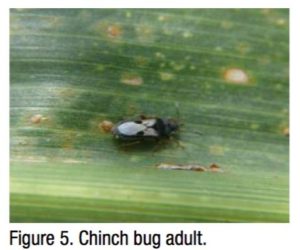
larvae are white colored grubs with a distinct dark-brown to orange head capsule (Figure 6). Immature larvae are about 1/16 inch long and grow to about 1 1/4 inches long when mature. They can be distinguished from other grubs by the V-shaped pattern of spines under the abdomen. Japanese beetle larvae feed on plant roots.
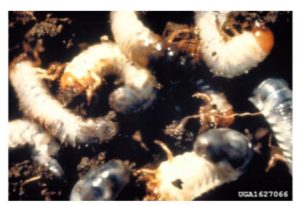
Figure 6. Japanese beetle larvae. Photo courtesy of John A. Weidhass, Virginia Polytechnic Institute and State University, Bugwood.org.
Management Approaches
Rescue treatments are available for some insects; however, timing is critical, making preventative treatments attractive and essential for some species. Insecticidal seed treatments can help to control several early season insects for up to 30 days after planting. Insecticide seed treatment products, such as clothianidin, can help reduce damage caused by secondary pests including: seedcorn maggot, white grub, wireworm, black cutworm, Japanese beetle larva, and chinch bug. Control of chinch bug may require higher rates of clothianidin. Scout fields on a regular basis, recording which insect pests are found and how many. Treatment action thresholds (Table 1) can vary by state, pest, and stage of crop development. Consult with an Extension entomologist and/or agronomist for local recommendations. If a threshold is met, apply the appropriate insecticide promptly and according to label requirements.
Table 1. General treatment recommendations and action thresholds for early season corn insects.
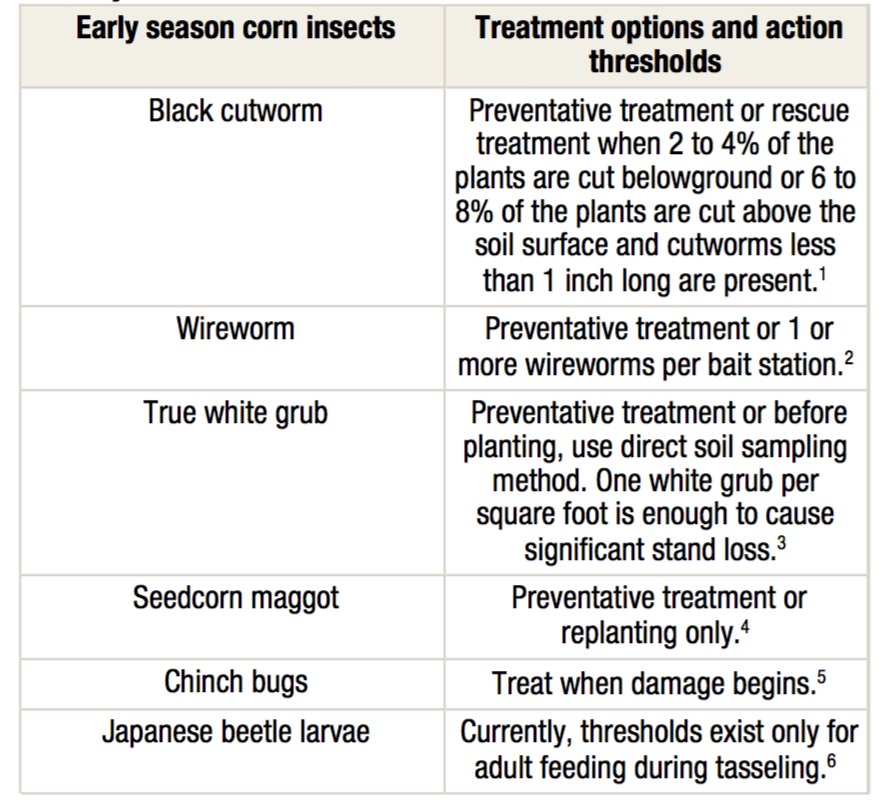
Sampling Methods
Direct soil sampling can be used to determine the presence of white grubs and Japanese beetle larvae. Examine a 1-foot by 2-foot by 6-inch deep volume of soil and count the number of grubs per sample. Take one soil sample for every 1 to 2 acres a few days prior to planting.Sampling Methods
Bait stations for wireworm sampling consist of approximately 1/2 cup each of untreated wheat and corn seeds placed 4 to 5 inches deep in the soil. A piece of black plastic covered by a larger piece of clear plastic can be placed on the soil surface above the trap to increase soil temperature and facilitate germination. Traps should be installed 2 to 3 weeks prior to planting and placed uniformly throughout the field.
Baited wire traps can be used to sample many of the belowground corn insects including: wireworms, white grubs, Japanese beetle larvae, and seedcorn maggots. Traps consist of 20 untreated corn seeds spaced evenly along a 2-foot long by 3-inch wide strip of wire mesh in 2-inch deep furrows and covered with soil. Wire mesh should be bent lengthwise at a 90° angle to keep seeds in place. Traps should be installed 2 to 3 weeks prior to planting and placed uniformly throughout the field at approximately 1 to 2 traps per acre.
Scout for black cutworms 1 to 2 times a week beginning with plant emergence. Observe plants throughout the field for evidence of leaf feeding or cutting.
Scout for seedcorn maggots after planting by sampling the soil in areas where plants have failed to emerge. In these areas, dig up 2 feet of row in each of 5 areas of the field and examine ungerminated seeds for damage and the presence of maggots.
Sample for chinch bugs by examining leaves and roots of 20 plants in at least 4 locations throughout border rows for the presence of adults and nymphs.

